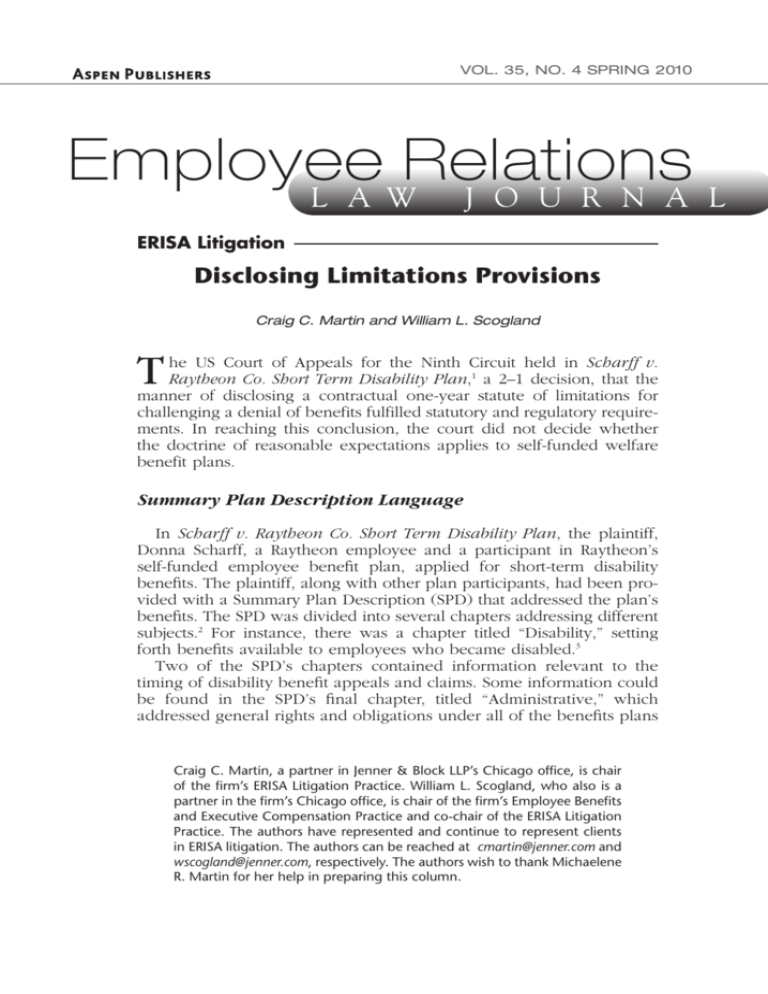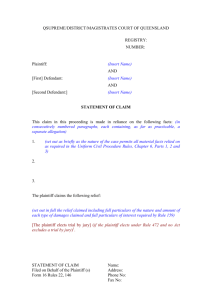
VOL. 35, NO. 4 SPRING 2010
Employee
Relations
L A W
J O U R N A L
ERISA Litigation
Disclosing Limitations Provisions
Craig C. Martin and William L. Scogland
T
he US Court of Appeals for the Ninth Circuit held in Scharff v.
Raytheon Co. Short Term Disability Plan,1 a 2–1 decision, that the
manner of disclosing a contractual one-year statute of limitations for
challenging a denial of benefits fulfilled statutory and regulatory requirements. In reaching this conclusion, the court did not decide whether
the doctrine of reasonable expectations applies to self-funded welfare
benefit plans.
Summary Plan Description Language
In Scharff v. Raytheon Co. Short Term Disability Plan, the plaintiff,
Donna Scharff, a Raytheon employee and a participant in Raytheon’s
self-funded employee benefit plan, applied for short-term disability
benefits. The plaintiff, along with other plan participants, had been provided with a Summary Plan Description (SPD) that addressed the plan’s
benefits. The SPD was divided into several chapters addressing different
subjects.2 For instance, there was a chapter titled “Disability,” setting
forth benefits available to employees who became disabled.3
Two of the SPD’s chapters contained information relevant to the
timing of disability benefit appeals and claims. Some information could
be found in the SPD’s final chapter, titled “Administrative,” which
addressed general rights and obligations under all of the benefits plans
Craig C. Martin, a partner in Jenner & Block LLP’s Chicago office, is chair
of the firm’s ERISA Litigation Practice. William L. Scogland, who also is a
partner in the firm’s Chicago office, is chair of the firm’s Employee Benefits
and Executive Compensation Practice and co-chair of the ERISA Litigation
Practice. The authors have represented and continue to represent clients
in ERISA litigation. The authors can be reached at cmartin@jenner.com and
wscogland@jenner.com, respectively. The authors wish to thank Michaelene
R. Martin for her help in preparing this column.
ERISA Litigation
discussed in preceding chapters. The chapter contained a section titled
“Your Right to Appeal a Denied Claim,” which explained the administrative procedure for appealing a denied claim to MetLife, the plan’s
administrator, which had sole discretionary authority to determine eligibility for benefits. The chapter also stated in its “Your Rights Under
ERISA” section that “[i]f you have a claim for benefits that is denied
or ignored in whole or in part, you may file suit in a state or federal
court.”4 On the same page as the section addressing administrative
appeals was a paragraph with a large-typeface, bolded heading, “Special
Rules for Disability and Health Claims.” This paragraph explained that
“[w]ith respect to disability and health plans … time limits for deciding
and appealing claims are significantly different from those for [other]
claims.”5 The “Administrative” chapter did not further address what
those time limits were.
Instead, the time limits for bringing a lawsuit for disability benefits
were contained in the “Disability” chapter. The last page of that chapter
contained a paragraph with a large-typeface, bolded, and italicized heading, “Claims Appeal Procedure.” The paragraph stated that the procedure for appealing a denied claim was explained in the “Administrative”
section. It further stated that “[i]t is important to note that under the
applicable [Plan] documents, any action at law or in equity must be commenced within one year of the denial of the appeal from an initial claim
denial, regardless of any state or federal statutes establishing provisions
relating to limitations of actions.”6
Plaintiff’s Claim
On April 15, 2005, MetLife received a claim for Short Term Plan (Plan)
benefits from the plaintiff. MetLife denied the claim in a letter dated
July 18, 2005.7 The plaintiff responded by submitting additional medical
information, but did not formally appeal the denial. MetLife reviewed
the additional information submitted by the plaintiff and sent a second
denial letter on September 16, 2005. On October 28, 2005, the plaintiff
formally appealed the denial of benefits.8 MetLife upheld its denial on
January 12, 2006. Its decision letter explained that “[t]his determination
is the final decision on review and constitutes completion of the full
and fair review required by the [Short Term] Plan and federal law.”9 The
letter also directed the plaintiff to “consult the information provided
concerning [her] rights, as set forth in the [SPD]” if she wished to pursue
the matter further. MetLife went on to explain that no further administrative appeals were available to the plaintiff, but she had a “right to
bring a civil action under Section 502(a) of [ERISA].”10 None of the letters
from MetLife mentioned the contractual one-year statute of limitations.
On June 14, 2006, MetLife wrote to the plaintiff explaining how it had
administered the claim and stating that her “denial of the claim was
upheld on January 12, 2006.”11
Vol. 35, No. 4, Spring 2010
2
Employee Relations Law Journal
ERISA Litigation
Plaintiff filed suit against the Plan under ERISA on February 1, 2007,
20 days after the one-year limitations period contained in the SPD had
expired.12 The plaintiff conceded that her complaint was untimely and
that the one-year limitations period was reasonable. Further, she did not
assert that the limitations provision was unclear.13 Instead, the plaintiff
argued that her late filing should have been excused because the limitations provision was not placed in an appropriate section of the SPD, and
because MetLife’s correspondence did not warn her of the limitations
period.14
ERISA Disclosure Obligations
Various statutory and regulatory disclosure provisions govern how
plans must provide participants with information regarding “circumstances which may result in disqualification, ineligibility, or denial or
loss of benefits,” such as the running of a contractual statute of limitations.15 Under ERISA, an SPD must explain these circumstances in a
manner “calculated to be understood by the average plan participant”
and the explanation must be “sufficiently accurate and comprehensive to reasonably apprise” participants of their rights and obligations
under the plan.16 In addition, limitations language cannot be “minimized, rendered obscure or otherwise made to appear unimportant”
and must be “described or summarized in a manner not less prominent than the style, captions, printing type, and prominence” used to
describe benefits.17 Limitations provisions must be placed near benefits
provisions.18
Doctrine of Reasonable Expectations
In arguing that the SPD did not meet ERISA standards, the plaintiff
sought to make use of the “doctrine of reasonable expectations,” which
provides that “the meaning of the terms in an insurance policy [are] to
be determined by considering it in light of whether a reasonable person
in the position of the insured would expect coverage.”19 The plaintiff
argued that the court should apply the doctrine of reasonable expectations to self-funded welfare benefit plans, and should further hold
that the placement and display of the contractual statute of limitations
violated plan participants’ reasonable expectations. Reasonable participants, the plaintiff argued, would expect to find claim deadlines in the
“Administrative” chapter rather than the “Disability” chapter, and would
expect deadlines to be displayed more conspicuously.20 In response, the
defendants argued that the doctrine of reasonable expectations does not
apply to self-funded welfare benefit plans.21
The court noted that there was tension in Ninth Circuit precedent
regarding whether the doctrine of reasonable expectations applies to
self-funded plans, having previously applied the doctrine to such plans
Employee Relations Law Journal
3
Vol. 35, No. 4, Spring 2010
ERISA Litigation
only in dictum. Here, the court assumed, without deciding, that the
reasonable expectations doctrine applied.22
The Court’s Decision
The court held that the Plan’s disclosure of the contractual statute of
limitations complied with the statutory and regulatory standards. First,
the court found it reasonable to place the limitation in the “Disability”
chapter, rather than the “Administrative” chapter. A reasonable plan participant applying for disability benefits, the court reasoned, would be
expected to read the entire “Disability” chapter of the SPD and to find
the limitation. Further, the court observed that MetLife’s letter informed
the plaintiff that she could find more information concerning her right
to sue in the SPD. Thus, the court held that the nearness requirement of
29 C.F.R. Section 2520.102-2(b) was satisfied.23
Second, the court found that the limitation was not minimized and
was written in a manner that could be understood by the average plan
participant. The court held that a reasonable plan participant whose disability claim had been denied would examine information that appeared
under a large-typeface, bolded, and italicized heading, “Claims Appeal
Procedure,” including, in this case, the contractual statute of limitations.
Further, the court found that the SPD did not hide the deadline in the
middle of other terms relating to appeals or put it in “fine print.” Because
the court found that the average plan participant in the plaintiff’s position would have located and understood the one-year limitations period
in the SPD, the court held that the placement and display of the limitations period met the statutory and regulatory requirements, even as
interpreted in light of the participants’ reasonable expectations.24
Dissent
In dissent, Judge Pregerson argued that the plan did not satisfy the
statutory and regulatory requirements because the SPD was not “written
in a manner calculated to be understood by the average plan participant.”25 Pregerson noted that the “Administrative” chapter is the only
place a participant would definitively learn about his or her right under
ERISA to file suit, but that the “Disability” section is the only place to
learn about the contractual one-year statute of limitations.26 Pregerson
stated that “the plan’s one-year limitation only becomes clear after a
coordinated reading of the two passages, bouncing a lay reader back
and forth in a way that obscures the importance of the one year filing
deadline.”27 Further, Judge Pregerson argued that the court should have
applied the doctrine of reasonable expectations here to prevent the
plaintiff’s claim from being dismissed for failing to meet the limitations
period.28
Vol. 35, No. 4, Spring 2010
4
Employee Relations Law Journal
ERISA Litigation
Take-Away Lesson
While the Scharff court held that Raytheon’s limitations disclosure
met regulatory and statutory requirements, a single vote saved the
limitations period. The best way to protect your plan is to ensure that
disqualifications and sections that deal with ineligibilities, denials, or
loss of benefits are clearly and conspicuously displayed in the Summary
Plan Description. Review any limitation language and ask whether it is
written in a way that can be understood by the average plan participant,
not the attorney who drafted it, and whether it accurately and comprehensively informs participants of their rights.
Notes
1. No. 07-55951, 2009 WL 2871229 (9th Cir. Sept. 9, 2009).
2. Id. at *1.
3. Id. at *2.
4. Id. at *1.
5. Id.
6. Id. at *2.
7. Id.
8. Id.
9. Id.
10. Id.
11. Id.
12. Id.
13. Id.
14. Id.
15. Id. at *4 (quoting 29 U.S.C. § 1022(b)).
16. Id. at *4 (quoting 29 U.S.C. § 1022(a) and (b)).
17. Id. at *4 (quoting 29 C.F.R. § 2520.102-2(b)).
18. Id. at *6 (citing 29 C.F.R. § 2520.102-2(b)).
19. Id. at *4.
20. Id.
21. Id.
22. Id. at *6.
Employee Relations Law Journal
5
Vol. 35, No. 4, Spring 2010
ERISA Litigation
23. Id.
24. Id. at *7.
25. Id. at *10 (quoting 29 U.S.C. § 1022(a)).
26. Id.
27. Id.
28. Id. at *11.
© 2011 Aspen Publishers. All Rights Reserved.
Reprinted from Employee Relations Law Journal Spring 2010, Volume 35,
Number 4, pages 81-85, with permission from Aspen Publishers,
Wolters Kluwer Law & Business, New York, NY, 1-800-638-8437,
www.aspenpublishers.com
Vol. 35, No. 4, Spring 2010
6
Employee Relations Law Journal



![[2012] NZEmpC 75 Fuqiang Yu v Xin Li and Symbol Spreading Ltd](http://s3.studylib.net/store/data/008200032_1-14a831fd0b1654b1f76517c466dafbe5-300x300.png)



